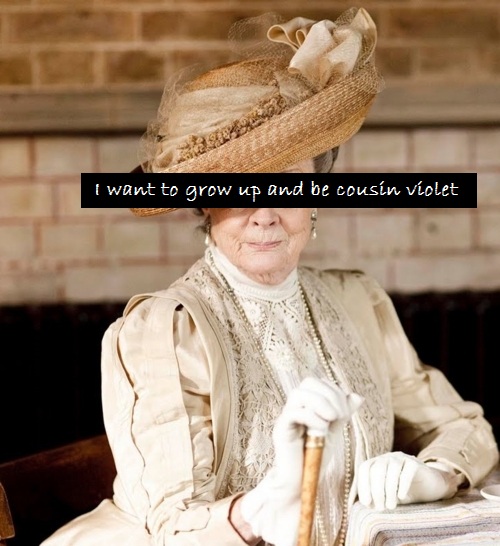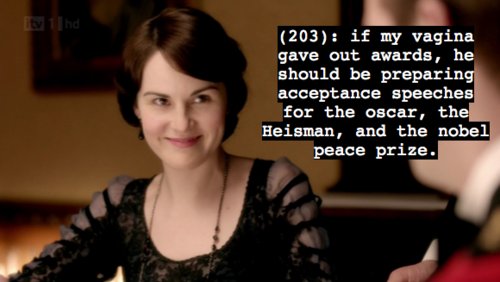Abbeyites Get Down with Downton Abbey
Downton Abbey has attained a significant cultural position. Indeed, this British miniseries (or is it a miniseries?) about the aristocratic Crawley family during the Edwardian era in England has captivated critics and viewers. Originally broadcast in the UK on ITV in 2009, Downton Abbey‘s first season aired on PBS in January 2010. It went on to win 6 Emmys, including the award for “Outstanding Miniseries or Movie,” a triumph it repeated this week at the Golden Globes. The January 8th PBS premiere of Downton‘s second season garnered 4.2 million viewers, which is 18% higher than season one’s ratings, and exceeds Mad Men‘s viewers. Needless to say, Downton Abbey has proved to be a hit for PBS, who co-produces Downton with British production house Carnival. This production context extends Masterpiece Theatre’s history of financing and distributing British period pieces. Moreover, Downton Abbey‘s cultural significance is evident in the various ways fans (known as Abbeyites) engage with the show and with the past it mediates for us.
For instance, Downton Abbey viewing parties have become trendy among affluent Abbeyites. Some of these viewing parties are quite extravagant, and offer guests an Edwardian feast and encourage period costumes. Some simpler parties offer cucumber sandwiches and drinking games, where you might take a shot every time Maggie Smith’s dowager makes a cutting remark. Want to throw a fete for your friends? Check out this DIY Downton Abbey party slideshow. These parties highlight how viewers attempt to recreate a time period they have never experienced, and know primarily through TV like Downton Abbey. Thus, as they imbue their 21st Century lives with Edwardian fashions and culinary dishes, Abbeyites become temporal tourists of a sort. And yet this nostaglic tourism, is, of course for a time period wholly constructed for them by Downton Abbey, and this is problematic in many ways, the least of which are the historical inaccuracies of the show. But I will address this later, first a few more examples of Abbeyite fandom.
A slew of Downton Abbey themed Tumblrs have sprung up ranging from the tame to the obscene. There is the The Lamps of Downton Abbey, which*gasp* allow fans to repurpose scenes from the show that include lamps. There is also Quite So, Downton Abbey, which seems to focus on straightforward fandom of specific dialogue/scenes, particularly those that relate to the conflicted romance between characters Mary and Matthew. A variety of Downton Abbey Tumblrs exist, but I would certainly be remiss if I did not mention one of the smutty ones, like Telegrams From Downton which, as the picture to your right might suggest, imposes more adult themes, like sex or getting trashed, onto images from the series. These memes point to the mutability of television storylines and the transmedia nature of Downton Abbey fandom. Furthermore, the irony of the memes is derived, in great part (lamps memes withstanding) from the juxtaposition of Downton’s visual simulacrum of Edwardian England with more modern slang or themes (again, see the vagina-themed meme above).
Fans also carve out their own narratives within the Downton Abbey in fan vids. The vid above, “Charlie & Sybil,” edits footage of Sybil from Downton and the character Charlie from recent film Brideshead Revisted to construct a love story between the two characters from different texts. This crossover vid points to the depth of fan engagement, as well as the intertextuality of Downton Abbey, as the vid’s author makes sense of the show through understanding another period piece, Brideshead. A range of Downton Abbey vids exist, and “Mary & Matthew” is a more straightforward mash-up of intimate moments between the show’s conflict-ridden lovers. Do not watch this vid if you hate U2 or children’s choirs, as it features a cover of “With or Without You” sung by kids, and has been altered to possess a more contrasted, sepia tone. Here again, fans make sense of the sentimental moments intertextually through popular music which the vid creator may associate with intense romantic entanglements. These vids subvert the original show by creating montages out of context and eking out new meanings for fans. Yet in many ways they work as promotional paratexts which work to heighten audiences engagement with Downton Abbey.
As fans engage with Downton Abbey, the show mediates the past for viewers. As I briefly mentioned above, several historians have publicly to denounced the program’s accuracy. These accusations of historical inaccuracies belie the constructed nature of histories. Historians and some critics also seem to react to the soapy, melodramatic treatment of Edwardian Britain, for this second season surpasses the drama of season one’s Pumakian interludes with sex, pregnancy, inter class romance, scandal, dramatic injury and murder trials. I am more apprehensive by what I see as an unabashed and unquestioning love of monarchy and an affirmation of aristocratic power and benevolence. Yes, there is a (superficial) Upstairs Downstairs – style engagement with servant life. Yet the show does not interrogate the power differential between lord and butler, and in fact constructs a sort of idolatrous paternalism wherein the aristocracy is shown to be stewards of the populace. No where is this more evident than when Downton becomes a military hospital. Iris Carmon unpacks this in her article “Why Liberals Love Downton Abbey,” critiquing Downton‘s superficial treatment of class and political power. Downton Abbey‘s popularity increases with each weekly PBS installment, the third season begins shooting in February (hence my hesitation to call this a miniseries), and there is even talk of a Downton film.
In many ways, I see Downton Abbey in itself a work of fandom. Creator/writer Julian Fellowes is admittedly a fan (and member, through marriage) of British aristocracy, and his novels Snobs and Past Imperfect, as well as his film Gosford Park, all pay homage at the alter of Britain’s elites. Downton could thus be seen as the fantastical product of an aristocracy fanboy. But the show’s prominence and wide distribution also point to its cultural power. As I have outlined, Downton Abbey‘s fans participate in an assortment of social activities that, I would argue, play with, critique, but, I argue, ultimately celebrate the program. What does it mean, then, for viewers to make sense of history through a show which constructs an imaginary account that privileges the ruling class so unequivocally? I do not know the answer, however this particular lens on history will certainly continue with Downton’s third season, and Fellowes upcoming miniseries Titatic, which will air on ITV in Britian and ABC in the US this April.





Very interesting and enjoyable column.
Re. “fans make sense of the sentimental moments intertextually through popular music which the vid creator may associate with intense romantic entanglements.” Maybe so, but the example you mention of the choir singing ‘With Or Without You’ did not originate from fan culture, but from the trailer campaign for Series 2: http://www.youtube.com/watch?v=yoe3CoxcYm0 after the campaign for Series 1 successfully used this choir singing The Police’s ‘Every Breath You Take’. For the recent Christmas special they sang Wham’s ‘Last Christmas’ (don’t look it up if you’re still watching series 2 – spoilers!)
Thanks, I didn’t actually see any of the trailers for this season before I watched it and just assumed that who ever edited the vid had chosen that song on their own. Good to know!